Making Homemade Butter
I have been making homemade butter for over a decade. It’s always interesting to see the variety of internet information on the subject, but let me tell you a secret. Instructions like, “Pour cream into a jar and shake until it turns into butter” are not a serious take on butter making–unless you are talking a fifth grade history lesson.
My love of homemade butter began many years ago when I was introduced to raw milk–that is milk that is not pasteurized or homogenized. I started using raw milk to get the benefits of a grass fed diet, but quickly recognized the better flavor. Before long, I began to appreciate an additional fringe benefit–the delicious cream that floated to the top of the non-homogenized product . Although many proponents of raw milk suggest shaking before each use to blend, my kids were never going to do this. So I started skimming off the cream to use for butter, or whipped cream, or pot de crème, or any of a whole variety of dishes that cream is a delicious part of. But butter was my mainstay.
If you don’t have access to raw milk, heavy cream (even UHT cream) right out of the grocery store can also be used to make butter. (I even found half gallons of organic heavy cream in our Costco recently at a more economical price.) Once you’ve located the cream, the rest is a snap. Note: If you are using cream from raw milk, it can be frozen while you accumulate enough to make butter.
How to Make Homemade Butter
Butter is made by agitating cream (I use a mixer) until clumps of butter separate from the buttermilk. Then you pour off the buttermilk (saving it for other uses) and rinse the butter thoroughly in very cold water. Finally you knead the butter to push out any trapped buttermilk, salt it (if desired) and you have butter.
It is possible to make butter by shaking cream in a jar, but it is much more effective to use mechanical methods. I burned out an inexpensive freestanding mixer in my early years of butter-making so I now recommend using a higher end mixer. Others report success with a blender or food processor (though I haven’t personally tried either). A cover or splash guard is a plus and at least one home butter-maker covers her mixer in plastic!
The temperature of the cream you start with is another factor to consider. If the cream is too cool, the butter takes longer to separate and if too warm, the butter can actually melt as it forms (the bigger problem of the two–ask me how I know). Research tells me that the ideal temperature is between about 50 and 65 degrees (though I don’t measure mine).
At an intermediate point in the churning process, the cream will turn into whipped cream. I think this is the most fun part of the whole process! If I want a little treat, I turn off the mixer, scoop some out, and add vanilla and sugar! I don’t even need to serve it on anything!
Not long after the whipped cream stage, the butter will separate. Then you pour off the buttermilk and rinse the butter (I use a strainer) under very cold tap water.
When the rinse water starts to look clear (versus looking a bit milky), I put it on a plate and knead it to push out any remaining buttermilk. Although butter has a fairly long shelf life, buttermilk spoils quickly and can cause the butter to become prematurely rancid if you don’t get enough out. A surprising number of small pockets of buttermilk can be hiding inside freshly made butter!
Finally, when the buttermilk seems to be mostly removed, I knead in some sea salt (optional). I usually store my butter in the refrigerator (or freeze if I make a lot) to reduce rancidity problems from any buttermilk I may have missed.
Defining Buttermilk
The other common misconception regarding butter making is about the liquid that you pour off the butter. While this can truthfully be called “buttermilk,” it bears little resemblance to store-bought buttermilk. Store buttermilk is a cultured product like yogurt (often containing live cultures too) and the flavor and texture are very different from the liquid you pour off your butter (unless you culture your cream first–see below).
In any case, your buttermilk leftovers are nutritious and can be used in place of milk in baked goods. You may also read that it can be used to produce ricotta cheese but there are some inherent limitations to this. Making any reasonable quantity of ricotta this way requires gallons of buttermilk and there are other methods that are more productive if ricotta is your goal.
In the end, if I am really pressed for ideas, I use extra buttermilk to water my outdoor (to avoid odor issues) plants followed by a water chaser (to avoid any acidity problems).
Cultured Butter
Tangy and flavorful, cultured butter is a popular option in Europe. In the US, however, it tends to be more of an artisanal product. But if you consider how yogurt gains flavor through the addition of beneficial bacteria, cultured butter starts to make sense. In fact the opportunity to make cultured butter has put many a reluctant home butter maker over the edge.
To make cultured butter, you add live cultures to your cream (before churning) then let it sit at (warm-ish) room temperature until thickened, about 12-24 hours. As an added benefit, if you culture the cream, the buttermilk you pour off will be thicker and have more of the cultured flavor that store buttermilk has.
I have made cultured butter using kefir and buttermilk for starter cultures. It is my favorite approach if I have the extra time. (Note that in producing any cultured product at home, discard any results that appear “off” because it is possible to culture the wrong bacteria by mistake).
Using homemade butter: eating, cooking, baking
Homemade butter is a taste delight, especially paired with fresh homemade bread. It is also delicious in cooking, but it may not perform the same as commercial butter in baking. The water content tends to be higher (no matter how much I knead it) which can be a problem if a baked good is sensitive to the moisture level (e.g. cookies which may spread too much–some brands of commercial butter may have this problem too).
Homemade butter is such a special treat, however, that I usually recommend eating it fresh or in butter-rich dishes like green beans almandine! If I take a hot loaf of bread out of the oven the same day I make butter, my kids think I’m the best Mom ever!
For another perspective see this article at Organic Gardening.

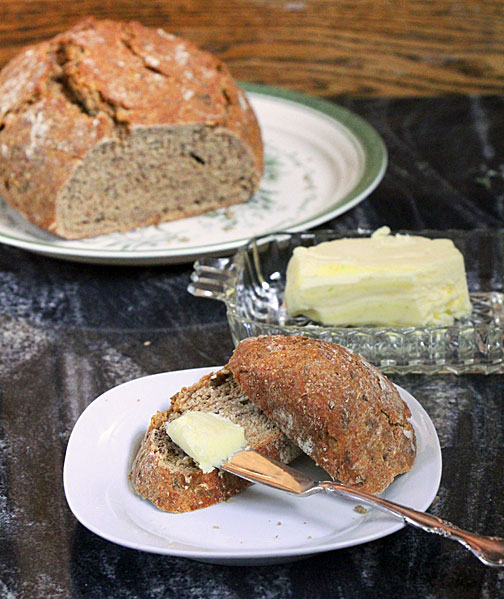
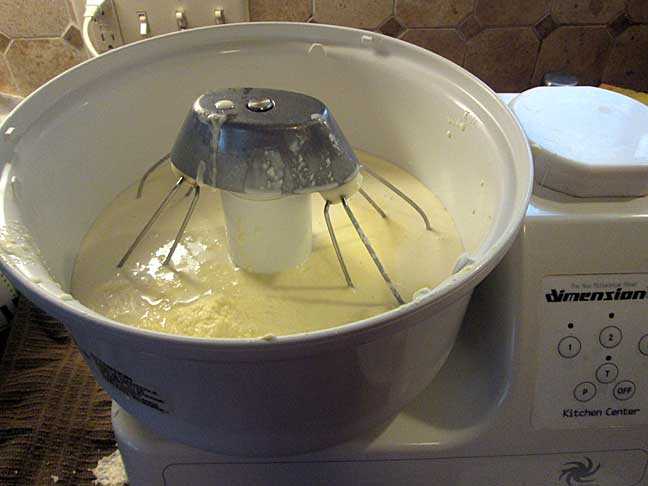
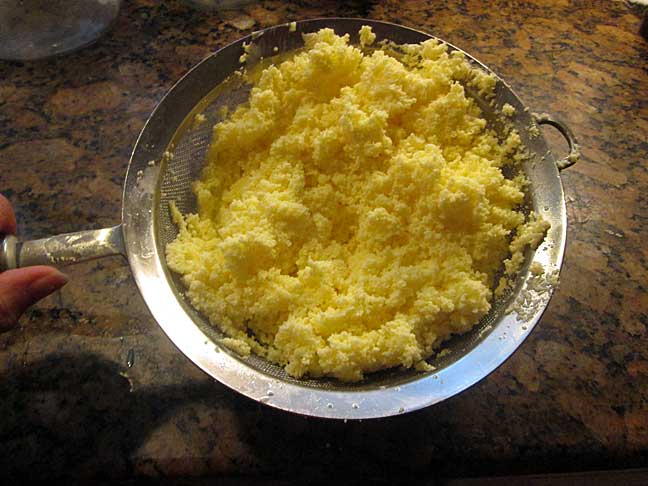

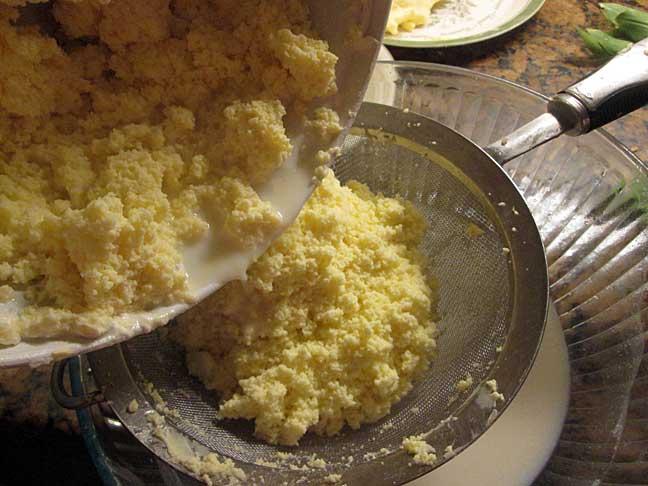



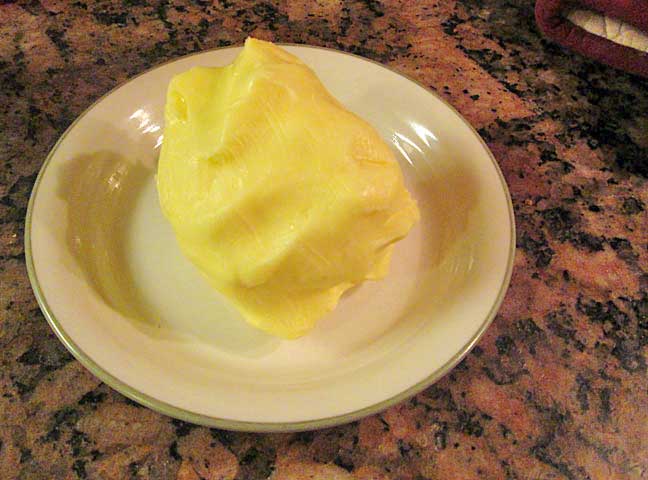
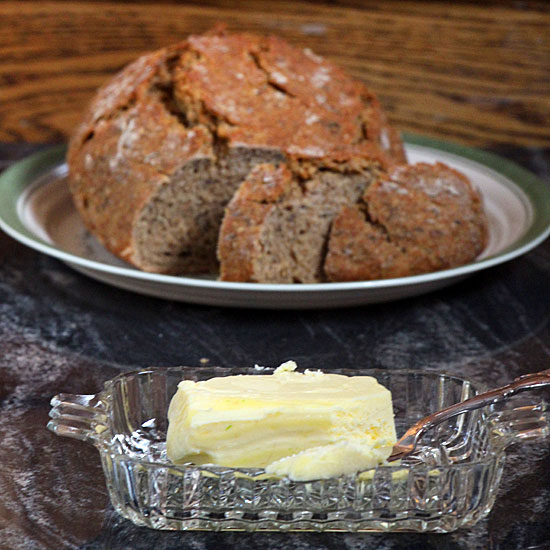
Pingback: Ramp and Wild Mushroom Compound Butter - Art of Natural Living
Pingback: Cod Poached in Herb Butter - Art of Natural Living
this is so informative, inger! i’ve never even considered making butter myself but i’m so very impressed by your endeavor!
Inger, how much cream do you use for a typical batch of butter? Good to know you can use any store bought heavy cream. Thanks.
You can use any amount of cream you want, since that is the only ingredient other than salt. You just need to make sure to not overfill your mixing bowl because the cream will initially expand as it whips. I go maybe half or a bit more full on the bowl. I prefer to make a lot of butter at once (I do perhaps three half full mixing bowls worth) because it seems more efficient but that is personal preference. (I usually do seven lasagnas when I make that 😉 ) Good luck with this and let me know if you have any other questions Mark.
I always thought that really good bread (homemade is best!) deserves home made butter. What a delicious snack.
I was so happy to have bread baking weather back, that I made 5 loaves last week Ronnie!
wow inger! you made your own butter, I have not seen this before. That’s genius to me. Appreciate your posting on this, good learning for me. YOu made me smile reading that buttermilk to be used on plants..just nvr thought of that at all 😀
I just hate to waste anything that might be nutritious to something, Lena–even a houseplant!
Making homemade butter is definitely impressive! I don’t think I’ll ever attempt it myself which makes me miss Freis Von Kiel’s butter even more. Have you tried theirs? I’m curious if it can even come close to your homemade version.
I have not tried that butter. The first time I remember eating cultured butter was at Old Town Serbian restaurant where we’d do some family dinners growing up. We never cared if the food took a long time as long as there was bread and their amazing butter.
Inger, you are so talented, a true artist. Sounds like this requires a lot of patience. But well worth it!
You know anything requires patience the first time you do it Freeda. Then it just gets to be habit. I am glad I kept up with this (and didn’t eat it all as whipped cream 😉 )
Your homemade butter looks fantastic, I didn’t even know it was possible (although what isn’t right?)! Homemade butter just reminds me of learning about colonial times where it was churned 😛
Cheers
Choc Chip Uru
I am glad I live in modern times with an electric mixer versus a butter churn though!
I love homemade fresh butter!
Look amazing Inger.
(I saved this one: thanks)
Isn’t it the best Gloria?!
Wow – impressive! I bet it tastes amazing! I’m afraid if I tried to do this I’d never get past the whipped cream phase – I’d probably stop right then and eat it. 🙂
Yes, it’s probably good that I make this in quantity (I freeze the cream so I can make a lot at a time) or the whipped cream might never make it to butter 😉
Wow Inger!!! Amazing…. you made your own butter! This is indeed all thumbs up to you and I can see that the butter turns out very nice and beautiful… I don’t think I have the patience to try home made butter. You are awesome, Inger and thanks for sharing Warmest regards 🙂
I do still have to buy additional butter–I don’t have enough cream to keep up with all the butter my husband eats! But we do enjoy the homemade we have.
I figured I’d better make butter Louise, since using all the cream in desserts would have been awfully fattening!
Now I’ve heard it all Inger! Seriously, you make your own butter too, lol!!! You never cease to amaze me!
I’ve actually made butter once in my life. I think it was when I was in Girl Scouts, lol…
Thank you so much for sharing, Inger…